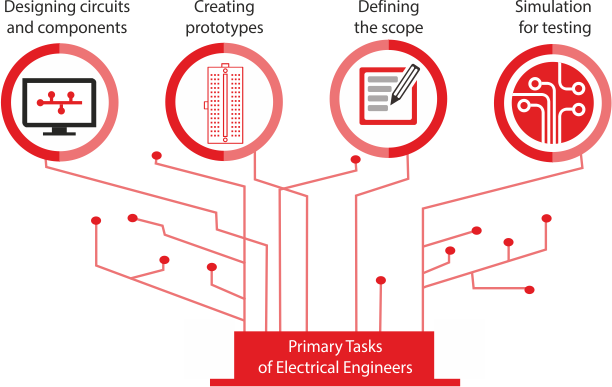ELECTRICAL CADD

OVERVIEW
Electrical Engineering is a field of engineering that deals with the technology of electricity. It involves the study and application of physics and mathematics in electricity, electronics, and electromagnetism.
Electrical engineers design electrical equipment and electronic products - from microchips & computers to electric power networks - and any other products that process information and transmit energy.
The primary tasks of Electrical Engineers, say in designing an electronics product is circuit designing or Schematic diagram.
Circuit designers have the responsibility of designing electronic circuits that make up electrical systems. Other responsibilities circuit designers have include designing different types of circuits and boards and creating signal processing filters. The minimum educational requirement is a bachelor of science in engineering, some employers require a master's of electrical engineering. Since circuit designs change frequently, this career requires a great amount of continuing education to keep up with technology updates.

Employment
Electrical Circuit desingers work in a variety of engineering industries including aerospace, automotive, chemical, construction, defence, electronics, consumer goods, marine, materials & metals, oil & gas, pharmaceuticals, power generation, rail, telecom, and utilities.Because circuit technology is constantly changing, new and updated circuits are continuously needed. For this reason, circuit designers should expect good employment opportunities in years to come.
The Role of CAD
An Electrical CAD software can automate all design tasks and facilitate drafting productivity. You can easily create electrical and electronic diagrams, schematics, control circuit diagrams, and documentation.
It would be as easy as placing electrical symbols and attaching the wires. You can then number the symbols, wires and tag components - doing so manually will be time-consuming and will not be accurate. CAD software will have a library of all electrical symbols, and they catch problems instantly.
In short, CAD software can save your time, reduce errors and enhance design communication.
Course Syllabus
-
AutoCAD Electrical
Overview :
AutoCAD Electrical, an integral part of AutoCAD suite of engineering software products, comes with powerful drafting tools for controls and schematic design. The rich repository of symbol libraries help designers increase the productivity of electrical design tasks.
Why should you learn?
AutoCAD Electrical helps you create electrical control design, documentation, panel layout, schematic design and project management, and carry out other common design tasks effectively.
Since it uses drag and drop file organization, enables reordering of files for electrical drafting projects, it reduces prototype development time and cuts data management time drastically, while boosting drafting productivity.Learning Objectives :
At CADD Centre, we help you master the following capabilities of AutoCAD Electrical:
- Controls Design using standards-based drafting and PLC I/O tools; automation of report generation, and organization of files and projects; Schematic symbol libraries, real-time error checking, schematic design tools.
- Cinematic-quality rendering and 3D animation, compelling visuals and presentations of Panel Layout module. And, project management that lets designers to collaborate and work with multiple people and teams.
Learning Outcome:
- You will learn the symbol naming conventions; usage of multiple symbol libraries, hydraulic and P&ID symbols; generate PLC layout modules, insert PLC modules, and organize PLC database files.
- You will learn to bring components into your panel for layout; to generate and update customizable reports, and use folders to organize drawings.
- You will know how to generate bill of materials reporting, and create PLC I/O drawings from spreadsheets.
- You will know how to do wire numbering and component tagging in circuits design.
Pre-requisite
Students pursuing diploma or degree courses in Graduation in Electrical Engineering can enroll in these courses.
Job Titles
Students who have completed these basic CAD courses can apply for the jobs of Circuit Design Engineer / Electrical Designer / Control Engineer / Energy Transmission Engineer.
Entry-level Salary
Upto Rs 3 lakh per annum (in India)
Diploma and Professional Courses
The professional in electrical CADD focuses on carrying out electrical designs; this ensures that participants are equipped with skills to become CAD Engineers or Electrical designers. As the course also covers project management concepts and tools, participants are equipped to be project managers and planning engineers as well. This holistic approach ensures that all requirements of the electrical design space are addressed.
Professional in Electrical CAD
The professional in electrical CADD focuses on carrying out electrical designs; this ensures that participants are equipped with skills to become CAD Engineers or Electrical designers. As the course also covers project management concepts and tools, participants are equipped to be project managers and planning engineers as well. This holistic approach ensures that all requirements of the electrical design space are addressed.
Diploma in Electrical CAD
The diploma in electrical CADD equips the students with the fundamentals of the different software needed for electrical design. This course ensures that participants perfect their skills of electrical computer aided design and drafting.
Pre-requisite
Students pursuing diploma or degree courses in Graduation in Electrical Engineering can enroll in these courses.
Job Titles
Students who have completed these high-end courses can apply for the jobs of Circuit Design Engineer / Planning Engineer / Chief Electrical Engineer / Chief Electronics Engineer.
Entry-level Salary
Upto Rs 4 lakh per annum (in India)
